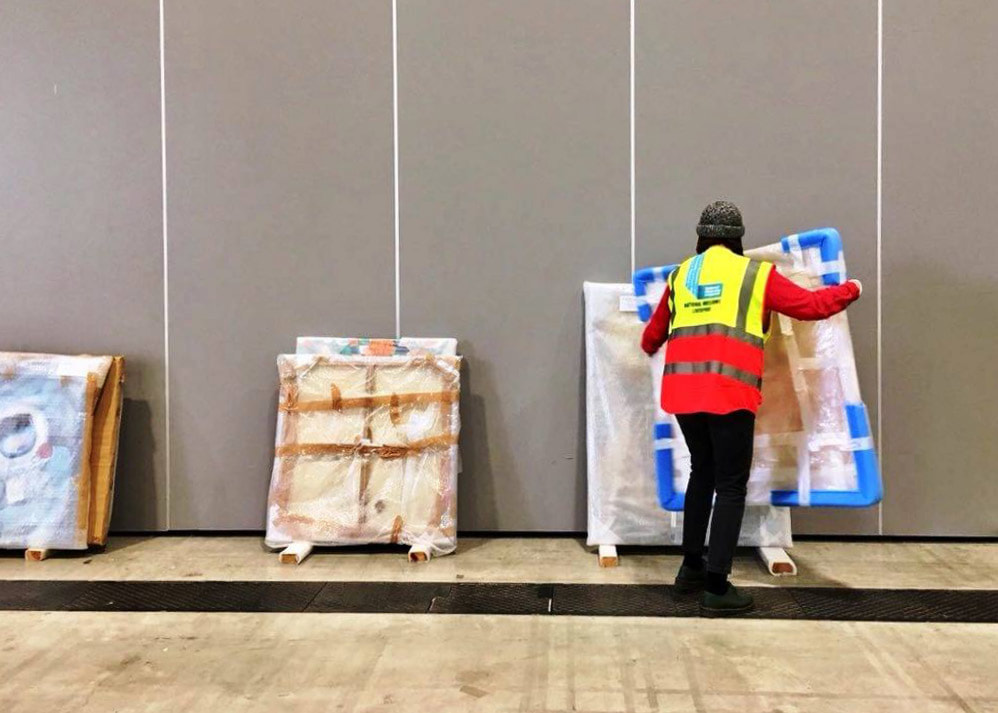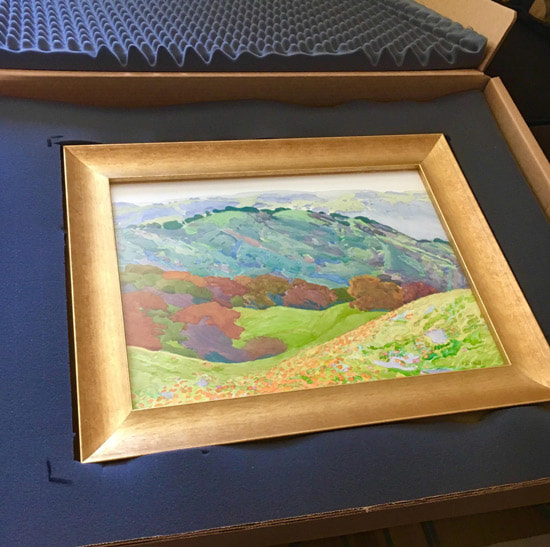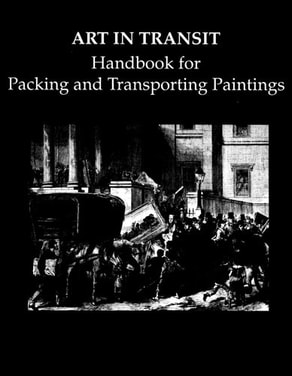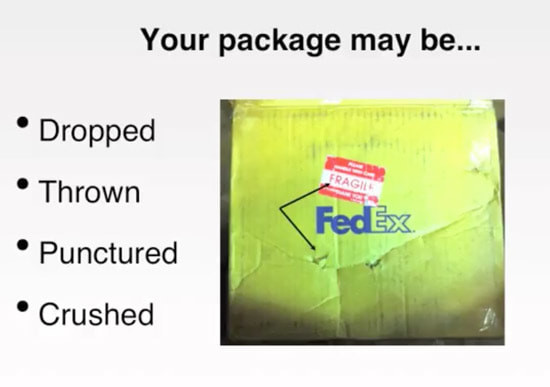- Home
- NEWS
-
PRACTICE
-
MARKETING
- How to write an Artist's Statement >
- How to write an Artist's Resume or CV >
- How to sign a painting, drawing or fine art print
- Business Cards for Artists
- How to write a press release for an artist
- The Private View Invitation
- Publicity for Juried Exhibitions
- Websites for Artists >
- Image & Video sizes for Social Media Sites
- How to be mobile-friendly
-
SELL ART
- FRAME ART
-
SHIP ART
-
COPYRIGHT
-
MONEY & TAX
- About + Help
- BANKING
Find out about how to weigh, measure, wrap, pack and label artwork which needs to be transported
|
This page covers:
A separate page covers |
Plus at the bottom of this page
LOTS AND LOTS OF TIPS and recommendations based on practical experience of wrapping, packing and shipping from:
|
For more details about PACKAGING MATERIALS for shipping art see the next webpage in this section
or click the link
or click the link
HOW TO: Create a package for artwork
|
|
Art in Transit: Handbook for Packing and Transporting Paintings
Editors: Mervin Richard, Marion F. Mecklenburg and Ross M. Merrill
Editors: Mervin Richard, Marion F. Mecklenburg and Ross M. Merrill
"This handbook is intended to be a reference for anyone involved in the packing and shipping of painting"
|
Publisher: National Gallery of Art (June 1991)
Ring-bound edition |
Read my review of Art in Transit: Handbook for Packing and Transporting Paintings. This is a very large and comprehensive handbook, written for art galleries and museums, which tells you what to do when packing and transporting valuable artwork. However it's also applicable to all those moving and arranging for the transport of artwork.
It's ridiculously expensive for the ordinary artist BUT This book is also available for free from the Smithsonian Institute (see link BELOW). Which is nice, because copies are now difficult to get hold of and astronomically expensive - however if you want your very own copy..... Smithsonian Digital Repository: Art in Transit: Handbook for Packing and Transporting Paintings (6.1 MB PDF FILE)
Title: Art in Transit: Handbook for Packing and Transporting Paintings Editors: Mervin Richard, Marion F. Mecklenburg AND Ross M. Merrill Publisher: National Gallery of Art (1991) BUY IN USA Art in Transit: Handbook for Packing and Transporting Paintings
|
HOW TO: LABEL a Package
|
BIG CLEAR ADDRESS LABELS
ABSOLUTELY EVERYTHING you ship needs a BIG CLEAR LABEL which is difficult to miss.
Tip - Do NOT Let Your Parcel Get Lost
Don't forget to use a waterproof marker or pen to include your address on the reverse side of the package. Just in case anything should go wrong...... |
MULTIPLE LABELS
|
For waterproof labelling materials see Packaging Supplies
HOW TO MEASURE Dimensions, Volume and Weight
|
It's ABSOLUTELY VITAL to check out dimensions when packaging and sending artwork - many services now price on dimensions as well as - or instead of - weight.
|
When comparing shipping rates make sure you know BOTH
|
|
DIMENSIONS
It's a really good idea to check the dimensions:
You may be required to do a bit of maths and work out the cubic volume that your parcel occupies. |
WEIGHT
Your biggest challenge may be about finding something which helps you weight your artwork! Robust kitchen scales are fine for small packets and parcels if they have a suitable upper weight limit. For heavy parcels you need something with an upper weight limit which exceeds the likely weight. Heavy parcels are often weighed on flat scales with a remote digital reader for the actual weight (on the basis you can't see the surface the parcel is sat on! One simple remedy for large artwork artwork you can hold in your hand is to use the bathroom scales. Pop on and weigh yourself and then add the packaged artwork while standing on the scales and weigh again. Typically you need two people - one to hold the artwork and the other to take the reading. This strategy is less useful if you're a bit heavy to start with and close to the limit on weight measured by your scales. |
HOW TO WRAP AND PACK YOUR ART
What happens when things go horribly wrong.....
|
In 2005, a quarter of all claims received by AXA (USA - which focuses on art insurance) involved works of art damaged in transit, versus 15 percent for theft or on-site burglary.
Learn the lessons of what happens when a shipper uses a commercial courier rather than a specialist art carrier. |
VIDEOS: How to pack your paintings for shipping
Here are some VIDEOS by way of an incentive to get the packing right;
and what to do when things go wrong...
and what to do when things go wrong...
|
This video by Lori McNee is a taster for what this page gets into in some depth - it's also a jolly helpful and informative video!
|
|
|
From SNAG 2012 Professional Development Seminar
Leila Hamdam, an artist, collector, curator who worked at a museum as the Registrar and Collection Manager and was responsible for all arrivals, packing and departure of artwork. Her presentation and video:
She recommends Estelle Berman's Condition Report |
|
|
BELOW Brigitte Martin shares her experience with a shipping disaster and how she documents the damage
This video is 10 MINUTES long. |
|
There are MORE EXCELLENT VIDEOS ABOUT PACKING ART BELOW!
ADVERT
HOW TO: Wrap and pack framed and/or glazed works
Personally I think it's a huge and expensive mistake to ship framed works.
Only frame shops make money from frames. Plus the shipping becomes very complex and you're probably shipping a frame which your client may want to change anyway!
SOME OF THE REASONS WHY IT'S A MISTAKE TO SHIP FRAMED WORKS
Do you need any more reasons?
Take away the anxiety by providing them with the materials which make it easy for them to do a good job.
SOME OF THE REASONS WHY IT'S A MISTAKE TO SHIP FRAMED WORKS
- One of my framers says most of his business comes from people who are having frames replaced!
- Never ever assume that people packing your work to send it back again will take the same care as you do.
- The money customers save on having the frame shipped could be spent on a much nicer frame at their end
Do you need any more reasons?
Take away the anxiety by providing them with the materials which make it easy for them to do a good job.
|
IF YOU MUST SHIP FRAMED/GLAZED WORKS...........
You will need STRONG EXTERNAL PACKAGING:
|
INTERNAL PACKAGING must be effective
|
REFERENCE - Large Paintings / Framed Works
- How do I package a painting | Saatchi Art - Covers paintings smaller / larger than 48"x48"; Framed paintings and Rolled canvas paintings
- How to Package an Oil Painting for Shipping | Sophie Ploeg - provides lots of images of how she packs an oil painting to send to an exhibition or customer
- Tina Mammoser Paintings: Artist question: packaging artwork - a comprehensive response to an email received from a fellow artist online asking about my packaging for shipping paintings.
- How to Safely and Securely Package Your Artwork for Shipping - When packing up your art for shipping to the gallery or to a customer, the most important thing is to have it arrive intact. Here are a few systems that I've used over the years
- How to create a bubble wrap envelope for your framed artwork - two methods for creating an envelope
- Katherine Kean Fine Art: Wrap Em Up, Ship Em Out - Fortunately the organizers of the exhibition had arranged for a discount to the artists on AirFloat Systems lined strong boxes. I really like using these boxes to ship because they give me great confidence that the artwork will arrive undamaged.
- Fool-Proof method for Shipping Art | by Laura den Hertog - I have been shipping art around the world for the last six years, and in all that time and hundreds of paintings later, I have only had one painting damaged by the post office.
- How to Pack Artwork - Prevent Damage Through Transit - Read my article about how to pack framed and frame-ready artwork to prevent any damage. Find information about packaging materials.
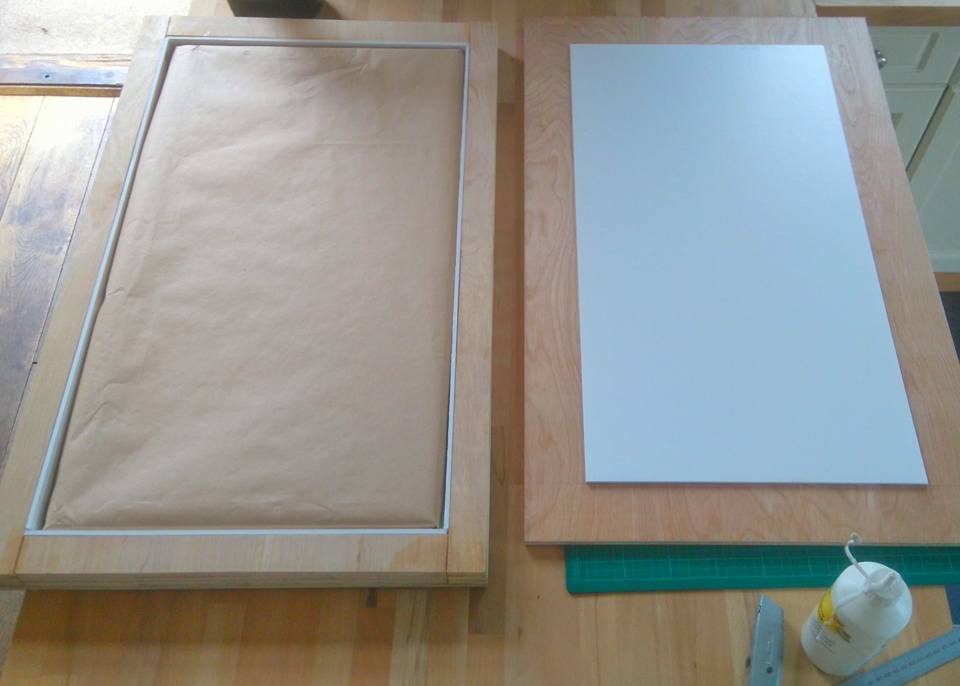
Alan Woollett is a UK Coloured Pencil Artist who exhibits his drawings of birds internationally. This is the plywood packing crate that he made to send a drawing to a museum in the USA. Note how the perspex glazed drawing is wrapped in brown paper. It fits precisely inside the plywood crate which is lined with foamcore.
REFERENCE: - Small works and miniature paintings
|
because the packages are small, they are more likely to get tossed around, stacked, and generally treated roughly. |
MORE VIDEOS about HOW TO PACK YOUR ART FOR SHIPPING
VIDEO: How to Ship A Painting - an excellent presentation by Xanadu Gallery
|
How to Ship A Painting - YouTube - Learn how to ship your art (paintings) in this free 50 minute video from Xanadu Gallery. Learn:
|
|
VIDEO: Best Way to Pack Paintings for Shipping - without a box! - what to do when you don't have boxes!
|
This is an EXCELLENT video by a man who demonstrates a very good way to ship paintings for those who don't have any boxes to pack the paintings in.
I cannot emphasise too much how right he is about:
I recommend you watch this video with the sound turned off. The soundtrack is a little intrusive so I suggest you turn your volume down - and keep watching. All the instructions are written on screen. Content - with annotations is great but sound is AWFUL!
|
|
VIDEO: How to pack a painting - advice from a gallery
|
This is a video made by the Agora Gallery who are increasingly providing decent resources for artists needing help with the basics.
It provides very straightforward, simple and precise explanations of what you need to do - as the painting is packed. This man is a tape gun expert! |
|
VIDEO: How to pack a painting - advice from a gallery
|
CAUTION!!
This is somebody who packs paintings on a regular basis hence has got the technique down to a fine art .....or does he?! He demonstrates using peanuts for packing and neatly illustrates why they are a mistake! Peanuts everywhere! He also hasn't removed the labels from the box BEFORE he started. |
|
ADVERTS
HOW TO: Package and Ship giclee prints / drawings / works on paper
I've personally received these tips from some of the best.
I also find it very interesting to see how others package their work when I buy artwork online! ;)
I also find it very interesting to see how others package their work when I buy artwork online! ;)
|
Some ship flat and some ship rolled. On the whole it seems to be the size and shape and whether or not they are matted which seems to determine whether they are flat or rolled.
|
You need to create an interior and an exterior package. Labels and paperwork are attached to the exterior package. The interior package prevents damage from the environment and exterior packing materials.
|
|
TO MAT OR NOT TO MAT
CREATE AN ARCHIVAL & WATERPROOF BARRIER
A BOARD PREVENTS BENDING
CHOOSE A SUITABLE ENVELOPE I prefer
|
VERY IMPORTANT:
HOW TO AVOID MOVEMENT INSIDE A PACKAGE If shipping flat then my practice is as follows:
|
REFERENCE: Packing Prints and Works on Paper
- How do I package flat artworks like drawings, collages, etc.? | Saatchi Art? - Covers Flat artworks under/over 48"x48"; Framed flat artwork and Rolled paper artwork
- How to Package Your Photographs - Framed or Unframed - For Shipping - by one of the most successful landscape photographers working in the American Southwest today.
- How to create a bubble wrap envelope for your framed artwork - two methods for creating an envelope
- Dena McMurdie Studios: Resource For Packaging and Shipping Your Art or Craft - I was looking for cellophane bags to place some of my prints, and even some of my originals, into for storage and shipping to reduce wear and dust.
SLIDESHOW: How to pack a poster or print for shipping - using a tube
|
Shipping art on paper can be tricky. This VIDEO is a slideshow which highlights what you should be thinking about if you use a tube.
REFERENCE: Unstretched Paintings
|
HOW TO: Package and ship 3D - sculpture and ceramics
|
Sculptures and ceramics present very particular problems
As a result when shipping artwork in three dimensions:
|
REFERENCE: Shipping Sculpture and ceramics
|
Custom Shipping Box / Design Your Work for Shipping by Harriete Estel Berman
|
|
SHIPPING ART: TIPS AND RECOMMENDATIONS
Below you can find TIPS and recommendations based on practical experience of wrapping, packing and shipping from:
- artists and photographers
- museums and conservators
- galleries and curators
- art societies
- art collectors
- shippers
Tips from artists and photographers
So what advice and PRACTICAL TIPS do artists have to offer about
- shipping and consigning artwork to galleries and other places where exhibitions are held?
- shipping to clients who have paid for their artwork?
|
TIPS FROM ARTISTS AND PHOTOGRAPHERS
|
Next you can read original blog posts and articles by various artists and photographers about what they think about when packaging their work - and lessons learned along the way
HOW TO WRAP AND PACK...... Detailed advice about
|
REFERENCE - General Advice on Packing
The interesting thing about packing is that the same questions get asked and the same answers are relevant year after year.
The interesting thing about packing is that the same questions get asked and the same answers are relevant year after year.
- MAKING A MARK: Packaging and posting artwork - Some guidelines on packaging and posting - updated in 2014 for subsequent changes in their website links.
- How to Pack Your Paintings for Shipping | Fine Art Tps with Lori McNee - The proper way to safely pack a painting, purchase the right insurance and what to do if your art is damaged.
- Hot Tips on Shipping Your Artwork | SDA NewsBlog - Navigating the options and challenges to sending the fruits of your creativity off to an exhibition can be daunting. Let artist (and former SDA Journal Editor) Patricia Malarcher take you through the process - with a little help from some friends.
- Artist, Emerging: Packing and shipping artwork - I'm not an expert on packing and shipping artwork, but I have worked as a gallery assistant and I've unpacked artwork for a couple of national juried shows. So I do consider myself an expert on how NOT to pack and ship artwork.
- Handle with Care | How to Ship Paintings | Artist's Network - Learn about shipping art with this article about how to ship paintings from the October 2012 issue of Pastel Journal-plus additional shipping
- How to package Artwork (for Shipping) | Rise Art - Comprehensive instructions on how to pack artwork
- 7 1/2 Practical Tips on How to Safely Package and Ship a Painting - Truly valuable paintings should always be shipped by an expert art moving company. Unfortunately, most of our artwork probably doesn't fit into that category, so it's up to us to package and mail our paintings ourselves.
Tips from Museums and Conservators
Tips and recommendations from Conservators and those packing for art museums
- one of the most quoted publications on the transport of art - Art in Transit: Handbook for Packing and Transporting Paintings (6.1 MB PDF FILE) FREE TO DOWNLOAD from the Smithsonian Digital Repository. Editors: Richard, M., Mecklenburg, Marion F. and Merrill, Ross Issue Date: 1991 Publisher: National Gallery of Art
- Marvelseal - to resist transmission of water vapour and atmospheric gases
- using corner protectors - because of the amount of stacking which can be involved in transit of large numbers of paintings
- conditioned silica gel - for control of relative humiidity
REFERENCE - Tips from Museums and Conservators
- Making a Mark Reviews | Art in Transit: Handbook for Packing and Transporting PaintingsThis technically detailed Handbook focuses on different approaches and procedures that will enable museum specialists (packers, registrars, curators, and conservators) to effectively use the results of the research of specialists in the field.
- Six Steps to Safe Shipment | Canadian Conservation Institute - Information to guide you through the packaging process + a few pointers that can make a big difference.
- Paintings: Considerations Prior to Travel - CCI Notes 10/15 - Paintings in transit are exposed to conditions that may promote cracking, cleaving, and flaking of paint and ground layers. Common hazards include vibration, shock, improper handling, and fluctuations in relative humidity and temperature (PDF Version, 841 KB)
- Wrapping a Painting - Canadian Conservation Institute | CCI Notes 10/16 - A painting must always be protected from both physical damage and changes in relative humidity and temperature. (PDF Version, 853 KB)
- Making Triwall Containers - Canadian Conservation Institute | CCI Notes 1/4 - Shipping containers are the first line of defence against shipping hazards. An appropriate container and an effective cushioning system work together as a system for preventing physical damage to fragile objects during shipment. (PDF Version, 1.02 MB)
- Corner Protectors - Preservation Equipment"We use these corners for shipping various packs of board and paper flat packs to protect vulnerable corners. Shipping damage is significantly reduced."
- Using Silica Gel in microenvironments (National Park service | Conserve O Gram)Silica gel controls relative humidity
- Transporting exhibits is an art itself - SFGateAsian Art Museum conservator Mark Fenn comments "we had to have the crates lined with Marvelseal and include conditioned silica gel to keep the relative humidity within the same limits required on exhibit and in storage."
- Marvelseal - Preservation EquipmentMarvelseal® is an aluminised polyethylene and nylon barrier film. Marvelseal® resists the transmission of water vapour and other atmospheric gases.
Tips from Galleries and Curators
Did you know the main risk to artwork shipped to and from galleries is DAMAGE rather than loss or theft?
- The reason is people do not always take PROPER PRECAUTIONS when packing works of art.
- However galleries ship art all the time.
- So what do galleries think about the way artists package their work when sending it in?
- How do they package artwork?
|
REFERENCE: Tips from Galleries and Curators
|
REFERENCE: Tips by Saatchi Art Online - Seller's Guide
|
Tips from Art Societies
|
Art Societies will not be using professional handlers, often do not have proper storage and knowledge of how to ship art can sometimes be very limited.
They're often in need of as much advice as artists. Fortunately some share what they know |
REFERENCE: Tips from Art Societies
|
Tips from Art Collectors
|
Art Collectors are often responsible for shipping their newly purchased art - however not all art collectors are experts at shipping art.
Tips which apply to artists, museums and curators apply equally to art collectors. However the REFERENCE section has articles directed specifically for collectors |
REFERENCE Tips from Art Collectors
|
Tips from Shippers
|
If shipping Internationally you also need to read carefully the the specific requirements of different shippers
- see the section on INTERNATIONAL POST AND SHIPPING SERVICES When getting shipping quotes, it always pays to ensure you know exactly what level of packaging your irreplaceable item is getting. You'll also find links to some of the packing materials mentioned below. |
REFERENCE Tips from Art Shippers
|
TIPS from General Shippers
The packaging used must always be in proportion to the weight and size of the item being posted. Our advice in these guidelines for internal and external packaging may not be applicable to all large and/or fragile items for which additional/sufficient packaging should always be used. |
REFERENCE FROM REPUTABLE SOURCES
|
ABOUT ART BUSINESS INFO. FOR ARTISTS
This website aims to provide a compendium of resources about the art business for artists. Please read "PLEASE NOTE"
It helps artists learn how to do better at being business-like, marketing and selling their art and looking after their financial security.
This website aims to provide a compendium of resources about the art business for artists. Please read "PLEASE NOTE"
It helps artists learn how to do better at being business-like, marketing and selling their art and looking after their financial security.
|
Copyright: 2015-2021 Katherine Tyrrell | Making A Mark Publications
- all rights reserved If you've got any suggestions for what you'd like to see on this website please send me your suggestion
|
PLEASE NOTE:
1) Content and the law change all the time. It's impossible to keep up with it if you're not working on the topic full time. 2) I research topics carefully. However, I am totally unable to warrant that ANY and/or ALL information is
|
3) Hence all information I provide comes without any LIABILITY whatsoever to you for any choices you make.
4) This website is FREE FOR YOU but not for me. Links to books are Amazon Affiliate links. Buying a book via this website means I get a very small payment which helps to fund and maintain this website. .I much appreciate any support your provide. Adverts are provided by Google AdSense - but the adverts do not mean I endorse the advertiser. |
- Home
- NEWS
-
PRACTICE
-
MARKETING
- How to write an Artist's Statement >
- How to write an Artist's Resume or CV >
- How to sign a painting, drawing or fine art print
- Business Cards for Artists
- How to write a press release for an artist
- The Private View Invitation
- Publicity for Juried Exhibitions
- Websites for Artists >
- Image & Video sizes for Social Media Sites
- How to be mobile-friendly
-
SELL ART
- FRAME ART
-
SHIP ART
-
COPYRIGHT
-
MONEY & TAX
- About + Help
- BANKING
